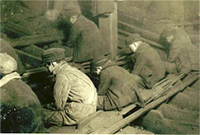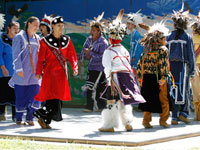1. [The American] will live 50 years instead of 35 as at present—for he will reside in the suburbs. The city house will practically be no more. Building in blocks will be illegal. The trip from suburban home to office will require a few minutes only. A penny will pay the fare.
True. In the 20th century, transportation and sanitation  advances led to the rise of developments around cities. Streetcars, trains, and, later, highways made it possible for workers to commute to urban centers for work and to travel outside of the city for their home life. Suburb development grew exponentially after World War II with the rapid spread of mass-produced housing such as Levittown.
advances led to the rise of developments around cities. Streetcars, trains, and, later, highways made it possible for workers to commute to urban centers for work and to travel outside of the city for their home life. Suburb development grew exponentially after World War II with the rapid spread of mass-produced housing such as Levittown.
2. Fleets of air-ships, hiding themselves with dense, smoky mists, thrown off by themselves as they move, will float over cities, fortifications, camps or fleets. They will surprise foes below by hurling upon them deadly thunderbolts. These aerial war-ships will necessitate bomb-proof forts, protected by great steel plates over their tops as well as at their sides.
True. Several aspects of this prediction came true, including the move to aircraft as a central defensive and offensive weapon. Later in the 20th century, the U.S. government spent significant resources on the research and development of a national missile defense system under the Strategic Defense Initiative Organization (SDIO), established in 1984.
3. Persons and things of all kinds will be brought within focus of cameras connected electrically with screens at opposite ends of circuits, thousands of miles at a span. American audiences in their theatres will view upon huge curtains before them the coronations of kings in Europe or the progress of battles in the Orient although they will not hear the crowds cheer or the guns of a distant battle as they boom.
False. In its actual form, this prediction foresaw the ability to see "live" events across the globe and also predicted the ability to hear events as they happened: "The instrument bringing these distant scenes to the very doors of people will be connected with a giant telephone apparatus transmitting each incidental sound in its appropriate place. Thus the guns of a distant battle will be heard to boom when seen to blaze, and thus the lips of a remote actor or singer will be heard to utter words or music when seen to move".
4. The owner of a [flying] machine, or even the man who did not own one, by patronizing the express lines, could live 50 miles away and yet do business in the city day by day, going by air line to his home each night.
False. Theodore Waters of the New York Herald actually predicted that workers could easily commute 500 miles to work each day, flying home each night, a further visualization of transportation innovation as well as of the relationship between work and home as the notion of suburbs emerged.
5. Coal will not be used for heating or cooking. It will be scarce, but not entirely exhausted. The earth's hard coal will last until the year 2050 or 2100; its soft-coal mines until 2200 or 2300. Meanwhile both kinds of coal will have become more and more expensive. Man will have found electricity manufactured by waterpower to be much cheaper.
True. Well into the 1800s,  Americans met their needs by harvesting energy and materials from plants, animals, rivers, and wind. By the 1830s, though, large-scale coal extraction had begun in Pennsylvania, Virginia, and beyond. By the 1910s, more than 750,000 coal miners dug and blasted upwards of 550 million tons of coal a year. Fossil fuels changed daily life in America, from travel to shopping, daily life to leisure. America's industrial ascendancy, however, caused problems for humans and the environment and in 2009, the threat of diminishing supplies is a serious concern.
Americans met their needs by harvesting energy and materials from plants, animals, rivers, and wind. By the 1830s, though, large-scale coal extraction had begun in Pennsylvania, Virginia, and beyond. By the 1910s, more than 750,000 coal miners dug and blasted upwards of 550 million tons of coal a year. Fossil fuels changed daily life in America, from travel to shopping, daily life to leisure. America's industrial ascendancy, however, caused problems for humans and the environment and in 2009, the threat of diminishing supplies is a serious concern.
6. Ready-cooked meals will be bought from establishments similar to our bakeries of today. They will purchase materials in tremendous wholesale quantities and sell the cooked foods at a price much lower than the cost of individual cooking. Food will be served hot or cold to private houses in pneumatic tubes or automobile wagons. The meal being over, the dishes used will be packed and returned to the cooking establishments where they will be washed.
True. In the early 20th century, new household technology was both accomplished and inspired by the tremendous increase in American industrial production. As in industry, mechanization and scientific management were part of a larger reorganization of work. And as in industry, efficient housekeeping was partially a response to labor unrest—both the "servant problem" and the growing disquiet of middle-class wives. A major proponent of the new housekeeping, Christine Frederick published books, articles, and pamphlets on scientific management in the home with a focus on greater efficiency, from cooking to washing dishes. This plan, in some ways predictive of the late 20th-century shift to pre-cooked meals in stores and restaurants, likely drew on this emerging ideology.
7. The living body will to all medical purposes be transparent. Not only will it be possible for a physician to actually see a living, throbbing heart inside the chest, but he will be able to magnify and photograph any part of it.
True. X-rays were first identified in the late 19th century, but were not widely used for medical research and treatment in 1900 when this prediction was written. Since 2005, X-rays were listed as a carcinogenic by the U.S. government. The author likely would not have envisioned the 21st-century field of endoscopy that allows medical professionals to see and photograph many parts of the body through a small tube.
 John Adams, from Abigail Adams (pictured). Abigail Adams wrote this to her husband in a December 23, 1782 letter. The original letter can be read
John Adams, from Abigail Adams (pictured). Abigail Adams wrote this to her husband in a December 23, 1782 letter. The original letter can be read  Woodrow Wilson, to Edith Bolling Galt (pictured). This is from a letter that widower President Wilson wrote from the White House on September 19, 1915, to Edith Bolling Galt, whom he would marry. The full text of the letter is in volume 34 of The Papers of Woodrow Wilson, ed. Arthur Stanley Link (Princeton, NJ: Princeton University Press, 1994), page 491.
Woodrow Wilson, to Edith Bolling Galt (pictured). This is from a letter that widower President Wilson wrote from the White House on September 19, 1915, to Edith Bolling Galt, whom he would marry. The full text of the letter is in volume 34 of The Papers of Woodrow Wilson, ed. Arthur Stanley Link (Princeton, NJ: Princeton University Press, 1994), page 491. Ronald Reagan, to Nancy Reagan (pictured). This is from a letter written on White House stationery by Ronald Reagan, to his wife Nancy on March 4, 1981. From Nancy Reagan, I Love You, Ronnie: The Letters of Ronald Reagan to Nancy Reagan (New York: Random House, 2002).
Ronald Reagan, to Nancy Reagan (pictured). This is from a letter written on White House stationery by Ronald Reagan, to his wife Nancy on March 4, 1981. From Nancy Reagan, I Love You, Ronnie: The Letters of Ronald Reagan to Nancy Reagan (New York: Random House, 2002). Theodore Roosevelt, about Alice Lee (pictured). This is from Roosevelt's diary entry of February 13, 1880. On that evening, he became engaged to Alice Lee, whom he married. On Valentine's Day, 1884, she died while giving birth to their daughter Alice. Roosevelt's mother died the same day. His diary entry for that day is simply a large black X with the words, "The light has gone out of my life." The Library of Congress has made scans of the original diary pages, available online
Theodore Roosevelt, about Alice Lee (pictured). This is from Roosevelt's diary entry of February 13, 1880. On that evening, he became engaged to Alice Lee, whom he married. On Valentine's Day, 1884, she died while giving birth to their daughter Alice. Roosevelt's mother died the same day. His diary entry for that day is simply a large black X with the words, "The light has gone out of my life." The Library of Congress has made scans of the original diary pages, available online 

 White actor, singer, and dancer, Thomas D. Rice, wrote and performed "Jim Crow" (sometimes called "Jump Jim Crow" because of the first line of the chorus) in 1829 or 1830. To perform the song, Rice dressed in tattered rags and frolicked comically to impersonate a very low caricature of a black man. His performances became an overnight sensation among white audiences, and he performed all over the country. He then took his act to Britain and France, where it became an even bigger hit.
White actor, singer, and dancer, Thomas D. Rice, wrote and performed "Jim Crow" (sometimes called "Jump Jim Crow" because of the first line of the chorus) in 1829 or 1830. To perform the song, Rice dressed in tattered rags and frolicked comically to impersonate a very low caricature of a black man. His performances became an overnight sensation among white audiences, and he performed all over the country. He then took his act to Britain and France, where it became an even bigger hit. Segregated public transportation began in the North before the Civil War. In many parts of the South, a black could not travel at all, unless he or she was accompanying (or accompanied by) a white, or carrying a pass from a white person.
Segregated public transportation began in the North before the Civil War. In many parts of the South, a black could not travel at all, unless he or she was accompanying (or accompanied by) a white, or carrying a pass from a white person. Douglass may not have been the very first, but he appears to have been one of the first. African Americans in New England, beginning in late 1839, along with white abolitionists, with some successes, deliberately challenged extra-legal but fairly common Jim Crow accommodations on railroads, on stagecoaches, in churches ("Negro pews"), and in schools. The persistence of Jim Crow practices in the North, however, gave Southern slave-holding whites the opportunity to reproach even abolitionist Northern whites for "not treating their free blacks better."
Douglass may not have been the very first, but he appears to have been one of the first. African Americans in New England, beginning in late 1839, along with white abolitionists, with some successes, deliberately challenged extra-legal but fairly common Jim Crow accommodations on railroads, on stagecoaches, in churches ("Negro pews"), and in schools. The persistence of Jim Crow practices in the North, however, gave Southern slave-holding whites the opportunity to reproach even abolitionist Northern whites for "not treating their free blacks better." Woodrow Wilson, who had been born in Virginia, soon after he took office in 1913, began a government-wide segregation of blacks and whites in Federal workplaces, restrooms, and lunchrooms. The policy appears to have been instituted after Wilson's Georgia-born wife Ellen visited the Bureau of Printing and Engraving in Washington and "saw white and negro women working side by side." Wilson's Secretary of the Treasury, William McAdoo (also Georgia-born, and soon to be the Wilsons' son-in-law) took the hint. Shortly thereafter, Assistant Secretary of the Treasury John Skelton Williams issued an order segregating the races in the Bureau. A Washington-wide order, covering all Government offices, followed, and soon all Federal offices everywhere in the country were covered by the same order.
Woodrow Wilson, who had been born in Virginia, soon after he took office in 1913, began a government-wide segregation of blacks and whites in Federal workplaces, restrooms, and lunchrooms. The policy appears to have been instituted after Wilson's Georgia-born wife Ellen visited the Bureau of Printing and Engraving in Washington and "saw white and negro women working side by side." Wilson's Secretary of the Treasury, William McAdoo (also Georgia-born, and soon to be the Wilsons' son-in-law) took the hint. Shortly thereafter, Assistant Secretary of the Treasury John Skelton Williams issued an order segregating the races in the Bureau. A Washington-wide order, covering all Government offices, followed, and soon all Federal offices everywhere in the country were covered by the same order.
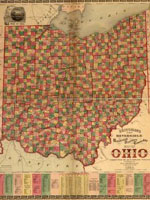
 In her diary, 18-year-old Emmeline B. Wells describes her experiences on the trail from Nauvoo, IL, to Garden Grove, IA. In 1846, Mormons, followers of the Church of Latter-day Saints, began to migrate west from their settlement in Nauvoo due to persecution, following a trail that, for much of its length, closely followed the Oregon Trail. Wells's diary describes the first half of this journey; as 1846 ended, the Mormons would winter in Iowa and then continue on to the territory that would become Utah. Wells relates experiences both general to all trailgoers and specific to women—the diary ends with her husband unexpectedly abandoning her, and her grief at the event.
In her diary, 18-year-old Emmeline B. Wells describes her experiences on the trail from Nauvoo, IL, to Garden Grove, IA. In 1846, Mormons, followers of the Church of Latter-day Saints, began to migrate west from their settlement in Nauvoo due to persecution, following a trail that, for much of its length, closely followed the Oregon Trail. Wells's diary describes the first half of this journey; as 1846 ended, the Mormons would winter in Iowa and then continue on to the territory that would become Utah. Wells relates experiences both general to all trailgoers and specific to women—the diary ends with her husband unexpectedly abandoning her, and her grief at the event. Lee Summers Whipple-Haslam, near the end of her life, wrote a memoir of her experiences as a child traveling to and living in California during the Gold Rush. Whipple-Haslam's parents brought her to California in 1850, where her mother ran a boarding house and her father prospected. Critics accused the memoir, published in 1925, of being more nostalgic fantasy than precise memory, but it still provides one woman's latter-life interpretation of the Gold Rush and California settlement.
Lee Summers Whipple-Haslam, near the end of her life, wrote a memoir of her experiences as a child traveling to and living in California during the Gold Rush. Whipple-Haslam's parents brought her to California in 1850, where her mother ran a boarding house and her father prospected. Critics accused the memoir, published in 1925, of being more nostalgic fantasy than precise memory, but it still provides one woman's latter-life interpretation of the Gold Rush and California settlement.  In this excerpt from her September 23, 1881 diary entry, ethnologist Alice Fletcher describes her assumption of a Sioux Dakota name before spending a month and a half studying the lives of Native Americans in the Dakota Territory. Fletcher, a woman from a well-off family, had developed a vocational interest in ethnology that led her to undertake this study. Like many other male and female reformers of the day, she would go on to attempt to "civilize" Native American culture through education and political action.
In this excerpt from her September 23, 1881 diary entry, ethnologist Alice Fletcher describes her assumption of a Sioux Dakota name before spending a month and a half studying the lives of Native Americans in the Dakota Territory. Fletcher, a woman from a well-off family, had developed a vocational interest in ethnology that led her to undertake this study. Like many other male and female reformers of the day, she would go on to attempt to "civilize" Native American culture through education and political action.
 Read the
Read the 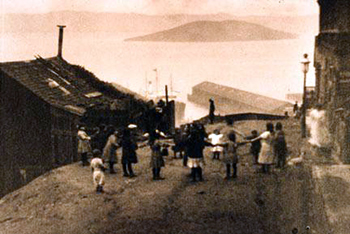
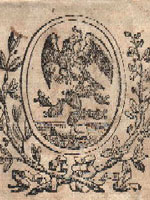
 From the late 1880s to around 1940, Yiddish-language theatre found a home in New York City—as did the wave of Jewish immigrants who brought the performance form to the U.S. Fleeing persecution in Russia, these immigrants, whether they chose to be performing artists or audience members, developed a unique theatre culture. Unlike the short variety acts of contemporary vaudeville, Yiddish theatre presented full-evening-length plays, accompanied by music or broken up with song-and-dance numbers. Plays adapted popular works by authors like Shakespeare and Anton Chekhov, drew from folklore and folk customs, and/or commented on recent events in the U.S. and abroad. Some addressed issues of assimilation, such as intermarriage and generational gaps, while others praised the virtues of the immigrants' adopted country—as did the musicals mentioned above.
From the late 1880s to around 1940, Yiddish-language theatre found a home in New York City—as did the wave of Jewish immigrants who brought the performance form to the U.S. Fleeing persecution in Russia, these immigrants, whether they chose to be performing artists or audience members, developed a unique theatre culture. Unlike the short variety acts of contemporary vaudeville, Yiddish theatre presented full-evening-length plays, accompanied by music or broken up with song-and-dance numbers. Plays adapted popular works by authors like Shakespeare and Anton Chekhov, drew from folklore and folk customs, and/or commented on recent events in the U.S. and abroad. Some addressed issues of assimilation, such as intermarriage and generational gaps, while others praised the virtues of the immigrants' adopted country—as did the musicals mentioned above. In 1852, the Tong Hook Tong Dramatic Company arrived in California, following the stream of Chinese immigrants who had come to the state with the 1848 gold rush. Greeted warmly by immigrant audiences, they accepted a contract to perform in New York City. In New York, they discovered the contract was a scam, and secured their own theatre space, performing for New Yorkers independently. Chinese opera bears little resemblance to European opera, and even less to the "Oriental" image of China then popular on the mainstream stage. Confused by what they were seeing, New Yorkers rejected genuine Chinese theatre that did not match up with contemporary media stereotypes.
In 1852, the Tong Hook Tong Dramatic Company arrived in California, following the stream of Chinese immigrants who had come to the state with the 1848 gold rush. Greeted warmly by immigrant audiences, they accepted a contract to perform in New York City. In New York, they discovered the contract was a scam, and secured their own theatre space, performing for New Yorkers independently. Chinese opera bears little resemblance to European opera, and even less to the "Oriental" image of China then popular on the mainstream stage. Confused by what they were seeing, New Yorkers rejected genuine Chinese theatre that did not match up with contemporary media stereotypes. In 1965, Luis Valdez, the son of Chicano migrant farm workers, founded the theatrical company El Teatro Campesino. El Teatro Campesino took theatrical performances—often without props, sets, or written scripts—directly to the camps of migrant farm workers. In its performances, the company sought to inspire farm workers to form a farm workers' union, but it also performed pieces based on Mexican popular theatre: corridas (dramatized ballads), peladitos (comic skits with an underdog protagonist), and religious pageants.
In 1965, Luis Valdez, the son of Chicano migrant farm workers, founded the theatrical company El Teatro Campesino. El Teatro Campesino took theatrical performances—often without props, sets, or written scripts—directly to the camps of migrant farm workers. In its performances, the company sought to inspire farm workers to form a farm workers' union, but it also performed pieces based on Mexican popular theatre: corridas (dramatized ballads), peladitos (comic skits with an underdog protagonist), and religious pageants. Prior to the Great Migration of the early 20th century, when African Americans came north in search of a better life, major record companies released African American music, but only as performed by white performers. Sensing the potential for a new market, the companies began to record African American performers and release their music on special labels targeted at African American audiences. Called "race records," these records were later marketed to white audiences as well. African Americans also established their own companies to distribute records—the first African American owned label, Black Swan, was established in 1921. Many styles of music associated with race records would later be recategorized as "rhythm and blues."
Prior to the Great Migration of the early 20th century, when African Americans came north in search of a better life, major record companies released African American music, but only as performed by white performers. Sensing the potential for a new market, the companies began to record African American performers and release their music on special labels targeted at African American audiences. Called "race records," these records were later marketed to white audiences as well. African Americans also established their own companies to distribute records—the first African American owned label, Black Swan, was established in 1921. Many styles of music associated with race records would later be recategorized as "rhythm and blues."
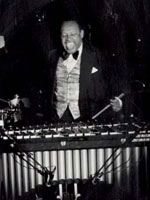
 The Institute for Dynamic Educational Advancement (IDEA) offers an
The Institute for Dynamic Educational Advancement (IDEA) offers an 

 advances led to the rise of developments around cities. Streetcars, trains, and, later, highways made it possible for workers to commute to urban centers for work and to travel outside of the city for their home life. Suburb development grew exponentially after World War II with the rapid spread of mass-produced housing such as Levittown.
advances led to the rise of developments around cities. Streetcars, trains, and, later, highways made it possible for workers to commute to urban centers for work and to travel outside of the city for their home life. Suburb development grew exponentially after World War II with the rapid spread of mass-produced housing such as Levittown. Americans met their needs by harvesting energy and materials from plants, animals, rivers, and wind. By the 1830s, though, large-scale coal extraction had begun in Pennsylvania, Virginia, and beyond. By the 1910s, more than 750,000 coal miners dug and blasted upwards of 550 million tons of coal a year. Fossil fuels changed daily life in America, from travel to shopping, daily life to leisure. America's industrial ascendancy, however, caused problems for humans and the environment and in 2009, the threat of diminishing supplies is a serious concern.
Americans met their needs by harvesting energy and materials from plants, animals, rivers, and wind. By the 1830s, though, large-scale coal extraction had begun in Pennsylvania, Virginia, and beyond. By the 1910s, more than 750,000 coal miners dug and blasted upwards of 550 million tons of coal a year. Fossil fuels changed daily life in America, from travel to shopping, daily life to leisure. America's industrial ascendancy, however, caused problems for humans and the environment and in 2009, the threat of diminishing supplies is a serious concern.